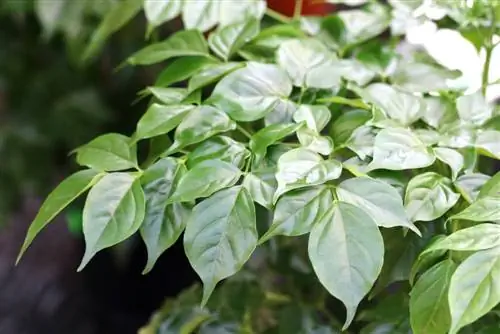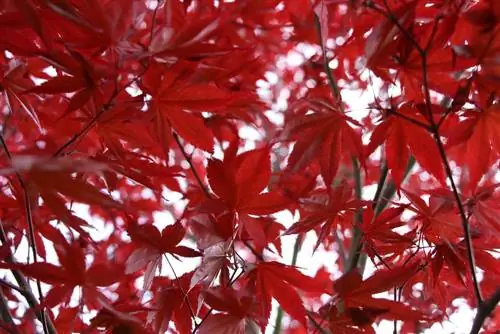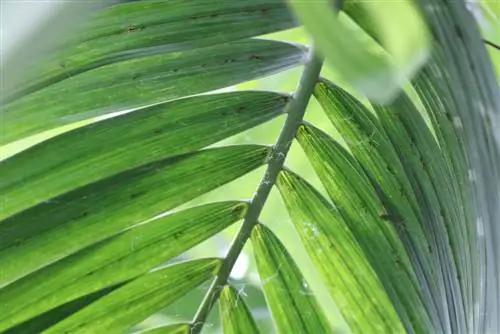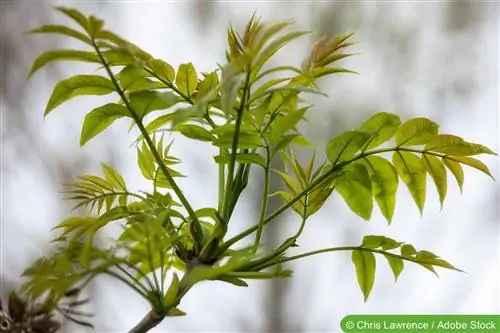- Author admin [email protected].
- Public 2023-12-17 03:39.
- Last modified 2025-01-24 12:45.
On other continents nature is sometimes more lavish at work than here. We cannot offer these plants the climate they love in our gardens. However, when it comes to a green appearance in our rooms, the Asian carpenter ash can move in immediately. The leaves develop quickly and are easy to please. A plant also for plant lovers without a green thumb.
Location
The carpenter ash or Rademachera sinica, as it is botanically called, is naturally designed to grow outdoors. However, a permanent outdoor residence is out of the question for this Asian trumpet plant in our latitudes. It is therefore important to offer her a space that is sufficient for her and also allows her to live to a ripe old age. The location in it should combine the following features:
- lots of light
- no blazing midday sun
- keep a sufficient distance from south-facing windows
- or mitigate the effects of the sun with a curtain
- the usual living room temperature is ideal
- in winter it can be 12 to 16 degrees Celsius
Tip:
The Rademachera with its green leaves not only ensures he althy indoor air, she also loves it herself. Rooms in which cigarette smoke constantly blows around your leaves are harmful to your vitality in the long term.
Outdoor location
At the right time, spending time outdoors can delight any Rademachera sinica. Preparations for such a trip can begin as soon as the last frosts have passed.
- from mid-May to September
- on the balcony or terrace
- Partly shaded to sunny
Although the winter waiting period was long, the move should not be rushed. The carpenter ash can only take its new place step by step so that the intensity of the sun does not catch it unprepared.
Substrate

If you plant an indoor ash tree, you don't have to spend a lot of money on expensive special soil. This plant makes do with standard soil for potted plants, which is made from compost. To increase the permeability of the substrate, you can enrich the soil with some coarse material before planting. Lava granules and expanded clay are ideal for this.
Pouring
This Asian plant probably brought a preference for balance with it from its homeland. When it comes to watering, this means that it can be too wet or too dry again. Extreme fluctuations are not tolerated and are promptly met with loss of leaves. The water supply should therefore ensure the following:
- only slightly moist substrate
- Consistent day after day
- Fill the stocky or planter with some expanded clay
- this prevents wet roots
So-called diving is ideal for watering the Rademachera. As soon as the surface of the soil has dried, the plant is dipped into a bucket of lime-free water. When no more bubbles appear, it is taken out again and, after draining, placed back in the saucer or planter.
Tip:
Compensate the Rademachera sinica for dry ambient air by spraying its leaves with lime-free water every 2-3 days.
Fertilize
The consumption of nutrients is low, so fertilization can be modest. During the main growing season from April to September, it is sufficient to add a commercially available liquid fertilizer for houseplants via irrigation water once a month. From October the gap will be increased to two months. If the indoor ash tree takes a break in a cool place in winter, fertilizing should also stop completely.
Cutting
The carpenter ash tolerates contact with scissors well, which is why there is no need to hold back when cutting is necessary. You should just wait until spring, as it is ideal for cutting this houseplant. In the following cases it benefits from the removal or shortening of its branches:
- Shoots of young plants regularly removed
- this ensures a bushy growth
- cut back heavily if there is strong growth and a lack of space
- take away shoots weakened by lack of light
- particularly necessary after a cool winter period
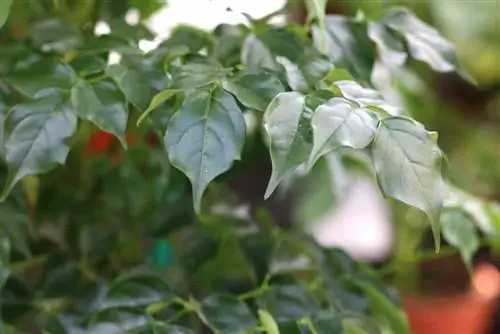
When making any pruning measures, remember that it is difficult for the carpenter ash to re-sprout from the parts that are already woody. Therefore, limit such cuts to what is absolutely necessary.
Repotting
The plant continues to grow steadily while the pot remains as it was created in the factory. At some point the two no longer fit together. Separation is inevitable and should be carried out as soon as the pot is completely rooted. Spring is the best time to repot the carpenter ash, then the roots can immediately venture into new areas as the growing season approaches.
- Get a larger pot with drainage holes, substrate and some expanded clay.
- First fill the new pot with expanded clay as a drainage layer.
- Then add some substrate over it.
- Take the plant out of its old home and shake out most of the old soil from the root ball. If it is difficult to remove, you can also spray the ball with a jet of lukewarm water.
- Place the plant in the middle of the new pot so that the original planting depth is maintained.
- Fill the gaps with substrate. Press it down again and again so that no unfilled gaps form.
- Water the newly transplanted plant well.
Propagation
The carpenter ash could be propagated from seeds, but that is hardly possible in this country. This is because the seeds required for this are rarely available commercially and the plant does not want to bloom indoors far from its home and therefore does not want to provide seeds. What she is not stingy with, however, are the green shoots, which can be wonderfully used as cuttings for propagation.
- Cut cuttings in spring
- ideally combine with cutting measures
- The head cuttings should be 10-15 cm long
- leave only the top pair of leaves, remove the remaining leaves
In order to grow new young plants from these cuttings that are identical to the mother plant, you will need the following materials and utensils:
- suitable soil, such as B. Pricking soil or a peat-sand mixture
- small cultivation pots with saucers
- one clear plastic bag per pot
- 3 wooden sticks approx. 20 cm long per pot
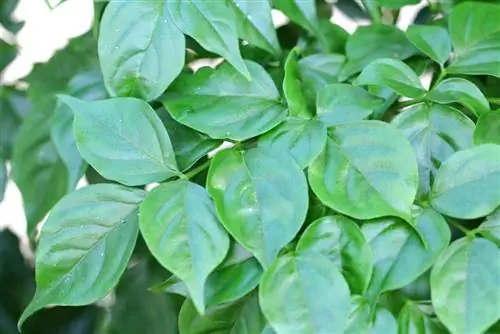
Once you have everything you need, you can take action as follows:
- Fill the growing pots with soil.
- Place one cutting in each pot so that only the upper third of it sticks out of the soil.
- Water all cuttings from below.
- Put 3 wooden sticks into the ground around each cutting with some space between them.
- Now put a transparent plastic bag over the wooden sticks and the cutting. It prevents excessive evaporation of moisture and thus ensures a humid climate that has a positive effect on rooting.
- Place the pots in a warm place, but be sure to protect them from direct sunlight.
- In the near future, ventilate the plastic covering daily and ensure an evenly moist substrate.
- As soon as new leaves appear on the cutting, you should remove the plastic bag.
- After the small cultivation pot has completely rooted, the young plant must be repotted.
Only after repotting is the new Rademachera fertilized like the mother plant and given the usual care.
Wintering
An indoor ash tree that enjoys an outdoor space in the summer unfortunately has to leave it again in the fall. However, it does not necessarily require typical overwintering, as is common with many other plants. This Asian plant can spend every day of the year in a warm room. However, an environment that is a few degrees cooler gives it a break in winter that it can really use. A Rademachera sinica that has overwintered in this way regularly shows a longer lifespan when observed.
- Bring the plant in as soon as the temperature drops below 10 °C at night
- If possible, offer bright and cool winter quarters
- with temperatures of 10-15 °C
- the warmer the area is, the brighter it should be
Adjust the amount of water and the watering intervals to the conditions in the winter quarters. The warmer and brighter the plant is, the more often it needs to be “dipped”. If it is kept quite cool and dark, watering it every two weeks will probably be sufficient.
- always water as needed
- so always do the finger test
- only dive when the surface of the earth has dried a few cm deep
Fertilizing can be stopped completely in cool winter quarters as the plant also stops growing. On the other hand, if it spends the winter months warm, it needs a few new nutrients every now and then. You should give it this every 8 weeks by adding some liquid fertilizer to the irrigation water.
Diseases
If the root ball of the carpenter ash dries out over a longer period of time, its leaves will quickly show large gaps. However, this should not be described as an illness, but rather due to the error in care. Always make sure that your soil remains slightly moist throughout, then you can enjoy plenty of green leaves. If some of the leaves have already fallen to the ground due to insufficient watering, then change your watering behavior now at the latest and then wait patiently for new leaves to sprout.
Pests
There is no need to fear any further diseases with Rademachera sinica, although its well-known pests could seek its lifeblood.
- warm overwintering promotes the spread of spider mites
- they especially love dry heating air
- pay attention to white webs
- are usually located near the leaf axils
- Leaves have small spots
If you overwinter your Rademachera in a warm environment, you should keep an eye on this danger and examine it at frequent intervals. Regular spraying of the leaves also ensures that the ambient air is humid and makes it so “unhabitable” for spider mites. In the early stages of the infestation, the tiny pests can be washed off the leaves with a jet of water in the bathtub. If the infestation is already advanced, you don't have to use chemicals or say goodbye to your houseplant.
Just try the following method:
- First water Rademachera sinica thoroughly.
- Put an intact plastic bag over the green foliage for several days
- Tie the bag tightly around the trunk so that no air exchange can take place.
The crawling pests will soon run out of oxygen and collapse. If a few specimens still survive, you can repeat the procedure.

